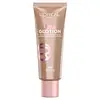Trend !t Up Glow Drops Versus L'Oreal Lumi Glotion
What's inside
What's inside
 Key Ingredients
Key Ingredients

 Benefits
Benefits

 Concerns
Concerns

 Ingredients Side-by-side
Ingredients Side-by-side

Water
Skin ConditioningButylene Glycol
HumectantGlycerin
HumectantMica
Cosmetic ColorantMontmorillonite
AbsorbentPhenoxyethanol
PreservativeAmmonium Acryloyldimethyltaurate/Vp Copolymer
Caprylyl Glycol
EmollientEthylhexylglycerin
Skin ConditioningNiacinamide
SmoothingPanthenol
Skin ConditioningPropylene Glycol
HumectantTin Oxide
AbrasiveTrisodium Ethylenediamine Disuccinate
Centaurea Cyanus Flower Extract
AstringentSynthetic Fluorphlogopite
Palmitoyl Tripeptide-38
Skin ConditioningHydroxypropyl Cyclodextrin
MaskingCI 77891
Cosmetic ColorantCI 77491
Cosmetic ColorantCI 77492
Cosmetic ColorantCI 77499
Cosmetic ColorantWater, Butylene Glycol, Glycerin, Mica, Montmorillonite, Phenoxyethanol, Ammonium Acryloyldimethyltaurate/Vp Copolymer, Caprylyl Glycol, Ethylhexylglycerin, Niacinamide, Panthenol, Propylene Glycol, Tin Oxide, Trisodium Ethylenediamine Disuccinate, Centaurea Cyanus Flower Extract, Synthetic Fluorphlogopite, Palmitoyl Tripeptide-38, Hydroxypropyl Cyclodextrin, CI 77891, CI 77491, CI 77492, CI 77499
Water
Skin ConditioningGlycerin
HumectantDimethicone
EmollientAlcohol Denat.
AntimicrobialButyrospermum Parkii Butter
Skin ConditioningCI 77891
Cosmetic ColorantAmmonium Polyacryloyldimethyl Taurate
Emulsion StabilisingSynthetic Fluorphlogopite
Polyglyceryl-6 Distearate
EmulsifyingMica
Cosmetic ColorantPolysilicone-11
Phenoxyethanol
PreservativePentaerythrityl Tetraethylhexanoate
EmollientJojoba Esters
EmollientCapryloyl Salicylic Acid
ExfoliatingCaprylyl Glycol
EmollientSodium Citrate
BufferingPolyacrylamide
CI 77491
Cosmetic ColorantBoron Nitride
AbsorbentPolyglyceryl-3 Beeswax
EmulsifyingCetyl Alcohol
EmollientC13-14 Isoparaffin
EmollientAdenosine
Skin ConditioningDisodium EDTA
Citric Acid
BufferingLaureth-7
EmulsifyingSodium Stearate
CleansingTin Oxide
AbrasiveCetearyl Alcohol
EmollientTriethoxysilylethyl Polydimethylsiloxyethyl Dimethicone
Skin ConditioningIsopropyl Titanium Triisostearate
EmollientAlumina
AbrasiveCeteareth-20
CleansingCalcium Chloride
AstringentWater, Glycerin, Dimethicone, Alcohol Denat., Butyrospermum Parkii Butter, CI 77891, Ammonium Polyacryloyldimethyl Taurate, Synthetic Fluorphlogopite, Polyglyceryl-6 Distearate, Mica, Polysilicone-11, Phenoxyethanol, Pentaerythrityl Tetraethylhexanoate, Jojoba Esters, Capryloyl Salicylic Acid, Caprylyl Glycol, Sodium Citrate, Polyacrylamide, CI 77491, Boron Nitride, Polyglyceryl-3 Beeswax, Cetyl Alcohol, C13-14 Isoparaffin, Adenosine, Disodium EDTA, Citric Acid, Laureth-7, Sodium Stearate, Tin Oxide, Cetearyl Alcohol, Triethoxysilylethyl Polydimethylsiloxyethyl Dimethicone, Isopropyl Titanium Triisostearate, Alumina, Ceteareth-20, Calcium Chloride
Ingredients Explained
These ingredients are found in both products.
Ingredients higher up in an ingredient list are typically present in a larger amount.
Caprylyl Glycol is a humectant and emollient, meaning it attracts and preserves moisture.
It is a common ingredient in many products, especially those designed to hydrate skin. The primary benefits are retaining moisture, skin softening, and promoting a healthy skin barrier.
Though Caprylyl Glycol is an alcohol derived from fatty acids, it is not the kind that can dry out skin.
This ingredient is also used as a preservative to extend the life of products. It has slight antimicrobial properties.
Learn more about Caprylyl GlycolCi 77491 is also hydrated iron III oxide. It's sole purpose is to give a red/pink hue to products.
Iron III oxides are classified as inorganic chemicals for coloring.
Synthetically created Ci 77491 is considered safer than those naturally found. This is because the synthetically created version may contain less impurities. Iron oxides are generally non-toxic and non-allergenic.
Learn more about CI 77491Ci 77891 is a white pigment from Titanium dioxide. It is naturally found in minerals such as rutile and ilmenite.
It's main function is to add a white color to cosmetics. It can also be mixed with other colors to create different shades.
Ci 77891 is commonly found in sunscreens due to its ability to block UV rays.
Learn more about CI 77891Glycerin is already naturally found in your skin. It helps moisturize and protect your skin.
A study from 2016 found glycerin to be more effective as a humectant than AHAs and hyaluronic acid.
As a humectant, it helps the skin stay hydrated by pulling moisture to your skin. The low molecular weight of glycerin allows it to pull moisture into the deeper layers of your skin.
Hydrated skin improves your skin barrier; Your skin barrier helps protect against irritants and bacteria.
Glycerin has also been found to have antimicrobial and antiviral properties. Due to these properties, glycerin is often used in wound and burn treatments.
In cosmetics, glycerin is usually derived from plants such as soybean or palm. However, it can also be sourced from animals, such as tallow or animal fat.
This ingredient is organic, colorless, odorless, and non-toxic.
Glycerin is the name for this ingredient in American English. British English uses Glycerol/Glycerine.
Learn more about GlycerinMica is a naturally occurring mineral used to add shimmer and color in cosmetics. It can also help improve the texture of a product or give it an opaque, white/silver color.
Serecite is the name for very fine but ragged grains of mica.
This ingredient is often coated with metal oxides like titanium dioxide. Trace amounts of heavy metals may be found in mica, but these metals are not harmful in our personal products.
Mica has been used since prehistoric times throughout the world. Ancient Egyptian, Indian, Greek, Roman, Aztec, and Chinese civilizations have used mica.
Learn more about MicaPhenoxyethanol is a preservative that has germicide, antimicrobial, and aromatic properties. Studies show that phenoxyethanol can prevent microbial growth. By itself, it has a scent that is similar to that of a rose.
It's often used in formulations along with Caprylyl Glycol to preserve the shelf life of products.
Synthetic Fluorphlogopite is the synthethic version of mica. It consists of fluorine, aluminum and silicate.
Synthetic Fluorphlogopite is used to add volume to products.
It is considered non-irritating on the skin.
Learn more about Synthetic FluorphlogopiteTin Oxide is an inorganic oxide used to add opacity and volume to a product. In nature, it is already found in mineral form. The main ore of tin is an opaque and shiny mineral called casseterite.
Tin Oxide helps remove translucency in a product, or make it more opaque. Besides adding opacity, tin oxide is used for bulking to add volume.
Water. It's the most common cosmetic ingredient of all. You'll usually see it at the top of ingredient lists, meaning that it makes up the largest part of the product.
So why is it so popular? Water most often acts as a solvent - this means that it helps dissolve other ingredients into the formulation.
You'll also recognize water as that liquid we all need to stay alive. If you see this, drink a glass of water. Stay hydrated!
Learn more about Water